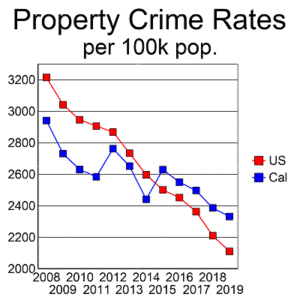California v. National Crime Trends

 Here is an update of the post two years ago comparing California’s crime rates with those of the country as a whole.
Here is an update of the post two years ago comparing California’s crime rates with those of the country as a whole.
The trend remains as I noted it then. Since California began its reckless drive to reduce prison populations regardless of the consequences, it has not shared in the property crime drop to the same extent as the rest of the country. For violent crime, the 2015-2016 increase was much larger, and it has not receded to the same degree as the rest of the country.
Proposition 47 was enacted late in 2014. Since 2014, property crime has dropped 18.7% in the country as a whole but only 4.5% in California. Supporters of this and later measures can say that enactment was followed by a decrease, not an increase, in crime. However, that simplistic answer glosses over the fact that this modest decrease occurred at a time when rates were plunging nationally. Thus the entirely possible criminogenic effect of these policies is masked, to some extent, by the national trend.
For violent crime, the country as a whole had recovered, as of 2019, from the 2015-2016 bump in the rate, with only a 1% rise over the 2014-2019 period. California still had an 11.4% higher rate as of 2019. This year, we know, things have gotten worse. How much of that is due to transient factors and how much to a continuing deterioration remains to be seen.
What we know for sure is that Californians have suffered far more from crime over the last six years than we would have if our state had followed the national trend. If there is an explanation for that other than our crime and punishment policies, I have yet to hear it.
Using the nation as a whole as the control group is also oversimplified, to be sure. Other states have also pursued prison population reduction policies. Some of them started at points more severe than the national average and were returning toward the mean, a change less likely to produce more crime than beginning with a moderate sentencing policy and moving toward the soft end. A more sophisticated analysis would compare states using a measure of sentencing toughness. Simple incarceration rate, as I have explained before, is not an accurate measure because it commits the Fallacy of the Irrelevant Denominator. So that is a project for another day.
